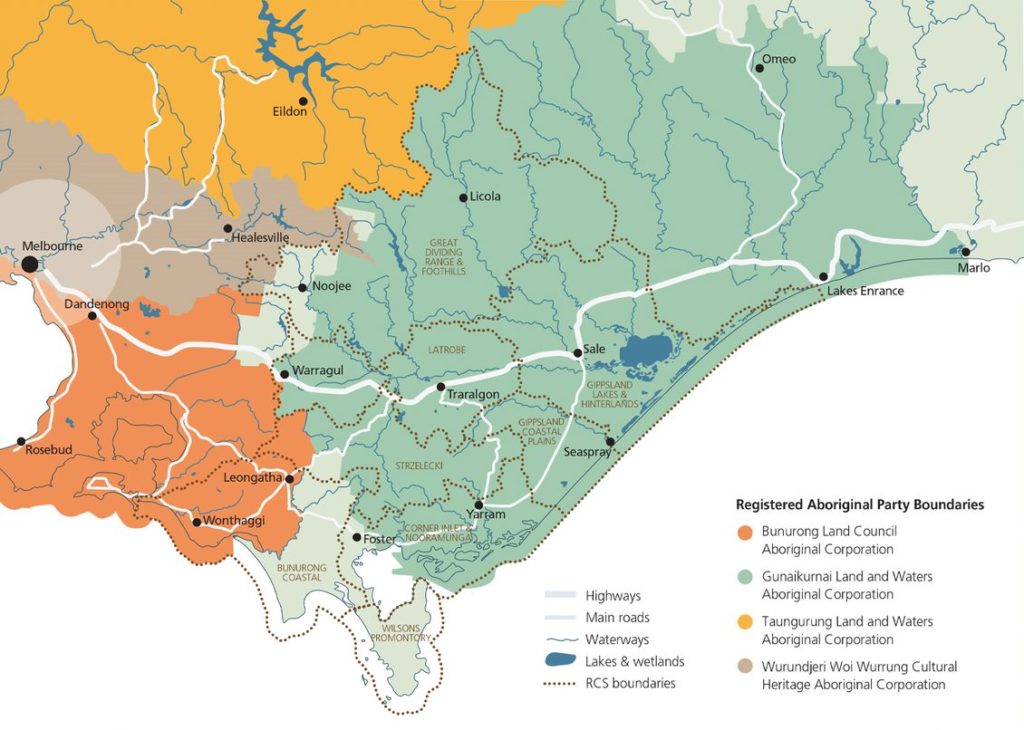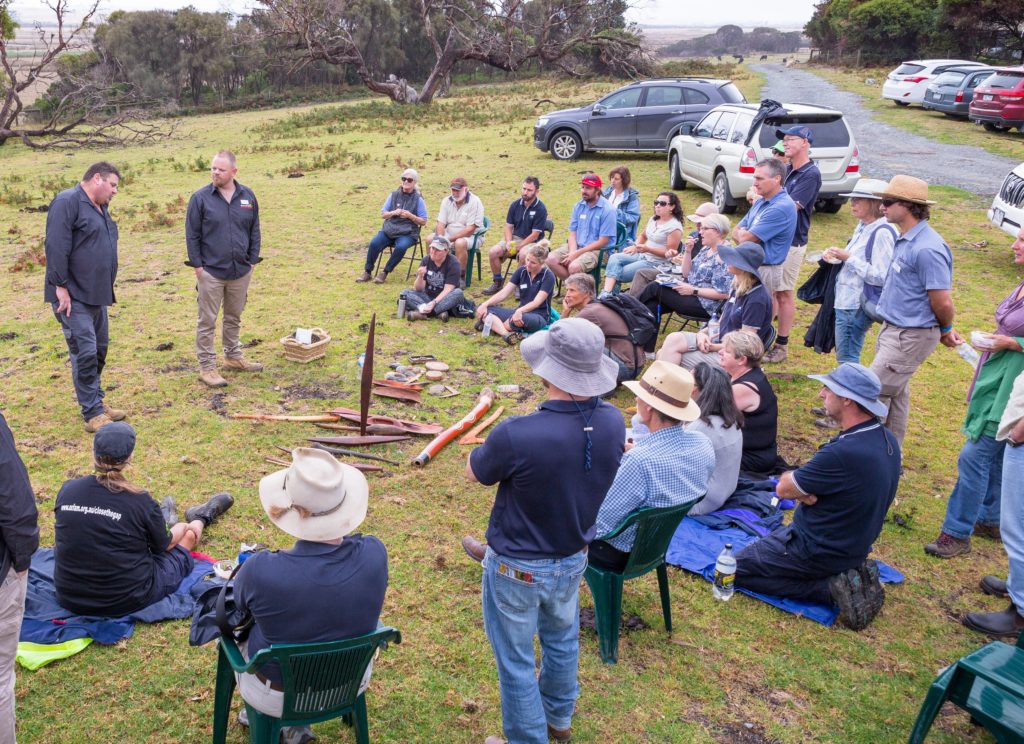Introduction
West Gippsland is a complex region, with a diverse array of high value environments and landscapes, from rare alpine peatland ecosystems to complex coastal wetland and estuarine systems that are internationally recognised for their waterbird habitat values. These natural landscapes hold special significance for the region’s Traditional Owners.
Traditional Owners through their respective corporations will ensure their aspirations will play an increasing role in how these landscapes are managed into the future. This will be facilitated by the modernisation of government legislation and policy toward Traditional Owner inclusion now and in the coming years.
There are three formally recognised Registered Aboriginal Parties within the broader West Gippsland CMA region. Each recognised Registered Aboriginal Party represents their Traditional Owners and Country. The recognised Registered Aboriginal Parties are:
- Gunaikurnai Land and Waters Aboriginal Corporation (GLaWAC)
- Bunurong Land Council Aboriginal Corporation (BLCAC)
- Wurundjeri Woi Wurrung Cultural Heritage Aboriginal Corporation (WWW).
GLaWAC covers approximately 80% of the West Gippsland CMA region, BLCAC 13% and WWW 1%. The remaining 6% presently does not currently have a RAP appointed. Within this area the Boonwurrung Land and Sea Council are an additional representative Aboriginal Corporation.
GLaWAC is also the prescribed body corporate on behalf of the Gunaikurnai people, for the purposes of the Native Title Act 1993 (Commonwealth). The State of Victoria has also entered into Recognition and Settlement Agreement with the Gunaikurnai people. The Recognition and Settlement Agreement, executed under the Traditional Owner Settlement Act 2010, affords Gunaikurnai people rights relating to the use of public land within their Agreement area.
The region’s Traditional Owners are seeking a more active role in the management of the region’s natural resources, which includes managing the region in accordance with cultural knowledge and practices.
Definitions
Country
Aboriginal culture revolves around relationships to the land and water. For Traditional Owners, Country is a part of who they are, just as they are a part of it. Country must be respected. Traditional Owners are authorised to speak for Country and its heritage.
Country Plan
A Country plan is one way for Traditional Owners to articulate their priorities and aspirations for looking after Country. These can be strategic plans that encompass physical and spiritual concepts of Country, provide a strategic basis for partnerships and identify management actions and economic opportunities.
Cultural Landscapes
Australia is a tapestry of interwoven cultural landscapes that are the product of the skills, knowledge and activities of Traditional Owner land managers over thousands of generations. They are a reflection of how Aboriginal people interact with the world, and are both material and symbolic. Cultural landscapes include Traditional Owner societies’ unique worldview, ontology, history, institutions, practices and the networks of relationships between human and non-human animals, plants, ancestors, song lines, physical structures, trade routes and other significant cultural connections to Country. Traditional Owner Cultural Landscapes reflect the management and modification of Country over many thousands of generations to provide maximum benefit to all of the inhabitants of Country, both human and non-human.
Native Title
Native Title is the recognition in Australian law that some Indigenous people continue to hold rights to their lands and waters, which come from their traditional laws and customs. As recognised in the Federal Court, the Gunaikurnai people hold Native Title under the Commonwealth Native Title Act.
Registered Aboriginal Party (RAP)
A Traditional Owner group legally recognised under Victoria’s Aboriginal Heritage Act 2006, with responsibilities for managing and protecting Aboriginal cultural heritage on Country. They are the primary guardians, keepers and knowledge holders of Aboriginal cultural heritage.
Traditional Owners
Aboriginal people who through membership of a descent group or clan, are responsible for caring for a particular Country with cultural authority to speak for Country and its heritage.
Traditional Owner Settlement Act 2010
The purposes of the Traditional Owner Settlement Act 2010 are to advance reconciliation, promote good relations between the State and Traditional Owners and to recognise Traditional Owner groups based on their traditional and cultural associations to certain land in Victoria.
Commitments
The RCS commitment to self-determination and Aboriginal participation will be delivered by enabling Traditional Owners to participate, if and how they choose and working collaboratively from the outset to plan and implement strategy and projects.
This commitment is based on mutual trust, respect and understanding in all areas of Natural Resource Management in West Gippsland.
In 2020, DELWP and Parks Victoria funded the development of the Victorian Traditional Owner Cultural Landscapes Strategy to support Traditional Owner rights and interests in managing Country.
The Regional Catchment Strategy supports the key principles outlined in the Cultural Landscapes Strategy, and will continue to work with each Traditional Owner corporation and their communities on implementing their respective objectives for Country, including initiatives from the Traditional Owner Strategic Framework for Managing Country.
The framework outlines how Traditional Owners will lead the planning and management of Country in line with their cultural obligations to care for Country for cultural, environmental and economic benefit. It will provide direction to the Victorian Government about how it can support this work and identifies existing barriers to address. This is a Traditional Owner authored document.
This framework was collaboratively designed by Traditional Owners and is intended to act as a thematic toolkit for Traditional Owners, and can be adapted to each group’s self-determined pathway for healing and caring for Country. The Framework has five Program Components describing the 10-year objectives of the Cultural Landscapes Strategy.
- Restore the Traditional Owner knowledge system
- Strengthen Traditional Owner resilience
- Enable Traditional Owner cultural landscape planning
- Embed Traditional Owner knowledge and practice into policy, planning and management of Country
- Enable Traditional Owners to apply cultural objectives, knowledge and practice in the management of public land.
Values
Gunaikurnai Land and Waters Aboriginal Corporation
The Cultural values of the Gunaikurnai are woven throughout the Gunaikurnai Whole of Country Plan, and encapsulated in the Whole of Country Plan principles2.
These include being able to practice the cultural obligations to heal and look after Country in a way that acknowledges that all of Gunaikurnai Country is linked with no separation between Traditional Owners, landscapes, waterways, coasts, marine environments and natural and cultural resources.
Managing a connected landscape means everything matters and that values exist even when they cannot be seen, for instance, even if they are under water, covered by vegetation or within landscapes changed by colonisation. Managing Country in a sustainable way like the Gunaikurnai have done for tens of thousands of years means ensuring everything taken can be replenished, resources are taken for the benefit of the Mob rather than individual gain, and leaving enough for others. These principles would help the RCS to put its stakeholders in good stead for a sustainable future.
The RCS will help to progress the implementation of the Gunaikurnai Whole of Country Plan and ensure Gunaikurnai objectives are acknowledged, supported and resourced.
Bunurong Land Council Aboriginal Corporation
BLCAC respectfully offer this statement of significance which covers all of our traditional land and water Country. Over 2,000 generations of our people have been here before us. Archaeological excavation within our Country has already demonstrated about 30,000 years of occupation.
These sites can show us how our ancestors interacted with their environment and how that interaction changed over time. We regard all evidence of our people’s occupation as sacred. No amount of data can compensate for the loss of a site but if we cannot literally preserve a site, the only other way it may be preserved is by way of careful data collection as part of a Cultural Heritage Management Plan.
The importance of the accuracy of this data being collected for protection is paramount as we regard it as sacred. It holds the stories of our people and our past. In some places our archaeology is the only thing that remains within a given landscape, the only thing left that hasn’t been changed or moved, and because of this, it is now sacred to us.
All of our Country is highly significant, every square inch, rock, leaf, dune and artefact. If we could attribute the cause of this blanket high-significance rating of our Country to any one thing, it would be that in Melbourne especially, so much has been destroyed and lost as the city grew, and so quickly. If you lose enough of something, what little you have left becomes so much more important. Similarly, when someone passes, their earthly possessions become more important to those they left behind. With regards to knowledge and stories, each of our Elders that passed away during early colonisation is the equivalent of a state library burning down today.
One Bunurong Elder of the time was famously quoted saying that, ‘Once we are gone, no one is going to know where anything is’, clearly considering the vast amount of knowledge he and his people had collected about the landscape, all written in their songs and stories.
Another Elder was noted as saying, ‘one day smart people will lament at our passing’, no doubt acknowledging again the ocean of information collected on every living thing here, every tree, every animal, and the key to the complex balance of all things that his people had managed to evolve and sustain. European people are still learning the complexities of Aboriginal culture.
Though we retain a wealth of stories of our people and Country, with no written language and with change occurring here so quickly, we have lost many of the ancient stories of this landscape. At the time, Bunurong peoples’ focus was more on trying to stay alive than on the luxuries of continuing to practice culture, which included the careful passing on of stories and knowledge, different levels of which would require certain initiations, performed over time.
The pressure is now on archaeological methodologies to make sure our Ancestors’ sites that are in harm’s way are found, and that they are excavated in a way that allows for science to give us back some of those lost stories. Every part of our Country is of high significance to our people past and present.”
Opportunities and Management Directions
A set of priority opportunities, management directions and outcomes have been developed that recognise the role of Gunaikurnai Traditional Owners, Bunurong Traditional Owners and Wurundjeri Traditional Owners in caring for land and sea Country.
There is a commitment to collaborating with the region’s Traditional Owners across all aspects of planning, strategy and project delivery with an emphasis on two-way knowledge sharing. These arrangements are tailored to each Country and cultural landscape context.
Through RCS implementation partners are also committed to recognising and fulfilling their legislative and policy obligations to consult and involve the respective Traditional Owners in the delivery of natural resource management programs in their respective RAP areas.
Priorities identified in collaboration with Bunurong Traditional Owners (BLCAC)
Priorities for BLCAC include:
- BLCAC is a key partner in projects from their inception within the BLCAC RAP Boundary area
- Educate people on the importance of protecting Bunurong cultural heritage by sharing stories and history of the Bunurong people
- Use of traditional ecological knowledge, with Bunurong Traditional Owners to inform the work of Natural Resource Management agencies and the wider community
- The priorities of Bunurong Traditional Owners are integrated with regional and landscape priories for natural resource management
- Pursue economic opportunities for BLCAC to create jobs in natural resource management.
Priorities identified in collaboration with Gunaikurnai Traditional Owners (GLaWAC)
Priorities for GLaWAC include:
- GLaWAC is a key partner in projects from their inception within the GLaWAC RAP Boundary area
- Working together to remove the perception that Aboriginal Cultural Heritage is a threat to landholders, distributing information throughout the community to improve people’s understanding of this area
- Use of traditional ecological knowledge, when permitted and with respect, to inform land, water and biodiversity management
- Undertaking collaborative planning and delivery activities to help manage Country priorities of the Whole of Country Plan, through government and Traditional Owners
- Priorities of Gunaikurnai Traditional Owners are integrated with regional and landscape priorities for natural resource management
- Strengthen connection to Country, increase opportunities for Gunaikurnai visitation, community gatherings on Country, opportunities to gather pass on lore between generations and pass on cultural practices, identify specific areas for this
- Opportunities to educate partner organisations and visitors to the area about significant places and culturally sensitive land use, Elder and Gunaikurnai led ranger activities
- Gunaikurnai increase their connection to the region through management operations, and the mapping of cultural values and sites, creation of a cultural values overlay, increase visibility of cultural values in the region.
Established management directions will be delivered through existing sub-strategies and action plans. Opportunities will be further developed or pursued through RCS implementation to help support Integrated Catchment Management in the region.
| MANAGEMENT DIRECTION | ESTABLISHED MANAGEMENT DIRECTION | OPPORTUNITY | PARTNERS |
|---|---|---|---|
| Traditional Owners to lead and own the application of their knowledge and practices in land, water and biodiversity management | ✔ | ✔ | GLaWAC, BLCAC, WWW, WGCMA, DELWP, PV, SRW, GW, MW, SGW, Landcare, AgVic, EPA |
| Formal agreements and collaborative partnerships between Traditional Owners and land, water and biodiversity managers | ✔ | ✔ | GLaWAC, BLCAC, WWW, WGCMA, DELWP, PV, SRW, GW, MW, SGW, Landcare, AgVic, EPA |
| Traditional Owners to partner on land, water and biodiversity projects from their inception | ✔ | ✔ | GLaWAC, BLCAC, WWW, WGCMA, DELWP, PV, SRW, GW, MW, SGW, Landcare, AgVic, EPA |
| Prioritise Traditional Owner Corporations to work on Country for Traditional Owners and Aboriginal people, and lead the incorporation of traditional ecological knowledge into land, water and biodiversity management | ✔ | GLaWAC, BLCAC, WWW, WGCMA, DELWP, PV, SRW, GW, MW, SGW, Landcare, AgVic, EPA | |
| Increase cultural understanding and resulting management of areas – including research, reading Country and survey work | ✔ | GLaWAC, BLCAC, WWW, WGCMA, DELWP, PV, SRW, GW, MW, SGW, Landcare, AgVic, EPA | |
| Implement priorities of the Gunaikurnai Whole of Country Plan through NRM agencies and Gunaikurnai Traditional Owners undertaking collaborative planning and delivery activities to help manage Country | ✔ | GLaWAC | |
| Support the development of a Whole of Country Plan for Bunurong Traditional Owners and work together in implementation | ✔ | BLCAC | |
| Support Traditional Owners to acquire water entitlements and access alternative sources of water to achieve their identified benefits and outcomes. | ✔ | GLaWAC, BLCAC, WWW, DELWP, WGCMA, SRW, GW, SGW |
Regional Outcomes
This section sets out the long term (20-year) and medium term (6-year) outcomes as they relate to the region’s land assets. The outcomes include those aligned with the statewide outcomes framework as well regionally specific outcomes developed in collaboration with Traditional Owner groups.
The RCS outcomes hierarchy can be found here with a more detailed matrix showing how the medium term outcomes align to local areas here.
Long term outcomes – by 2041 we will:
Regionally specific outcomes:
- Empower Traditional Owners to care and manage land and seas Country
- Recognise and establish formal provisions that protect Traditional Owners rights, interest, obligations and access to water.
Medium term outcomes – by 2027:
Aligned to the statewide outcomes framework
- The number of formal partnerships agreements between Traditional Owners and NRM agencies has increased.
Regionally specific outcomes
- The number of projects/programs that incorporate and deliver on Traditional Owner objectives for Country and priorities in Country plans has increased
- Understanding of cultural landscapes has improved supported by the development/renewal of Country Plans.
References
- VTOC. Victorian Traditional Owner Cultural Landscapes Strategy. North Melbourne: Victorian Traditional Owner Corporations. 2021
- GLAWAC. Gunaikurnai Whole of Country Plan. Bairnsdale: Gunaikurnai Land and Waters Aboriginal Corporation. 2015
- GLaWAC & WGCMA. Memorandum of Understanding [Internal document]. Gunaikurnai Land and Waters Aboriginal Corporation and West Gippsland Catchment Management Authority
- BLCAC & WGCMA. Memorandum of Understanding [Internal document] Bunurong Land Council Aboriginal Land Council and West Gippsland Catchment Management Authority.





